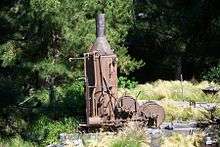Donkey puncher

A donkey puncher is the operator of a small steam donkey, a machine used in logging in the 19th and 20th centuries.[1][2]
Description

A donkey consists of a steam boiler and steam engine,[3][4] connected to a winch mounted on a sled called a donkey sled.[5][6] The donkeys were moved by simply dragging themselves with the winch line. They were used to move logs, by attaching lines to the logs and hauling them.[7][8]
The donkey puncher was the machine operator and engineer.[9][10] Use of the term gained currency in 1920.[11] In later times the donkey puncher was too far away from the end of the line to know what to do, so whistle codes (steam whistles) were employed.[12] The whistle operator was known as a whistle punk,[12][13] who was placed between the men attaching the cables (choker setters),[14] and the donkey puncher, so that he could see the choker setters.[12][15] When the cables were attached, a series of whistle blows signaled the donkey to begin pulling and the choker setters to stay out of harm's way.[12][16] This is an oversimplification of a closely orchestrated sequence of operations, where mistakes were often fatal and where good men stood in line for the jobs.[17] Although the steam engine, and its whistle, have been replaced by gasoline and diesel engines,[18] the whistle codes are still used in many current logging operations. The whistle has been replaced largely with airhorns.[19][20]
See also
- Geared steam locomotive – often used on forestry railways
- Lidgerwood – manufacturer of steam-powered logging equipment
- Steam locomotive
- Steam power during the Industrial Revolution
- Steamroller
- Steam tricycle
- Steam turbine
- Timeline of steam power
- Yarder – a larger steam-powered logging machine
References
- ↑ Barman, Jean (2007). The West Beyond the West: A History of British Columbia. University of Toronto Press. ISBN 9780802093097.
- ↑ Bellamy, Stanley E. (2007). Running Springs. Images of America. Charleston, South Carolina: Arcadia Publishing. p. 28. ISBN 0738546798.
- ↑ Hull, Lise (2007). Coos County. Images of America. Arcadia Publishing. p. 53. ISBN 0738548030.
- ↑ Albrecht, Bob (July 2, 2011). "Learning about the old way to log". The Columbian. Retrieved September 13, 2012.
- ↑ Leavell, Chuck; Mary Welch (2001). Forever Green: The History and Hope of the American Forest. Mercer University Press. p. 92. ISBN 0865549001.
- ↑ Bolling, Arthur Johnson (editor) (July–December 1920). Chicago Lumberman. Chicago, Illinois: Lumber World Review; Lumber Review Company. p. 127; Volume 39.
- ↑ MacConomy, Alma Deane (1968). Odd Jobs in Lumbering. Putnam Publishing Group. ISBN 978-0399604973.
- ↑ Schwantes, Carlos Arnaldo (1999). Hard Traveling: A Portrait of Work Life in the New Northwest. University of Nebraska Press. p. 103. ISBN 0803292708.
- ↑ Federal Writers Project (1972). Oregon: End of the Trail - American Guide Series. Scholarly Press. p. 369. ISBN 0403021863.
- ↑ Durston, Tammy (2010). Annapolis and the Gualala River. Images of America. Arcadia Publishing. p. 19. ISBN 0738581143.
- ↑ Dalzell, Tom; Terry Victor (2007). The Concise New Partridge Dictionary of Slang. Routledge. p. 211. ISBN 0415212596.
- 1 2 3 4 Rombes, Nicholas (2009). A Cultural Dictionary of Punk, 1974-1982. Continuum. pp. 305–310. ISBN 0826427790.
- ↑ Hughes, John C.; Ryan Teague Beckwith (2010). On the Harbor: From Black Friday to Nirvana. Stephens Press LLC. p. 16. ISBN 1932173501.
- ↑ United Press International (June 24, 1969). "Balloons assume role of Paul Bunyan's Blue Ox". Beaver County Times. Pennsylvania. p. C15.
- ↑ Francis, Bob (April 6, 1940). "Lingo of a mighty industry; Whistle Punk". The Vancouver Sun. p. 4.
- ↑ Associated Press (August 8, 1921). "Woodsmen on coast have own language". The Owosso Argus Press. Owosso, Michigan. p. 8.
- ↑ MacKay, Donald (2007). The Lumberjacks. Natural Heritage Books. pp. 179–181. ISBN 9781550027730.
- ↑ Trower, Peter (1999). Chainsaws in the Cathedral. Ekstasis Editions Canada Ltd. p. 150. ISBN 978-1896860466.
- ↑ United Press International (June 3, 1989). "Loggers roll into Seattle for rally". Ellensburg Daily Record. Seattle, Washington. p. 3.
- ↑ Associated Press (May 18, 1977). "Logging convoy is crossing Wyoming". Merced Sun-Star. Cheyenne, Wyoming. p. 15.
Further reading
- Laws, Larry (2011). Back Then: Memoirs of a Country Boy. Xlibris, Corp. p. 125. ISBN 1465357017.
- Miles, DJ (2009). Prindles and Prindels of Clinton and Franklin Counties, NY and Their Allied Families. AuthorHouse. p. 223. ISBN 1449042406.
- Ross, John (2004). Murdered by Capitalism: A Memoir of 150 Years of Life and Death on the American Left. Nation Books. p. 79. ISBN 1560255781.
- Stanley, David; Elaine Thatcher (1999). Cowboy Poets and Cowboy Poetry. University of Illinois Press. p. 276. ISBN 978-0252068362.
- Vaillant, John (2012). Am Ende der Wildnis: Umweltaktivist oder Ökoterrorist? (in German). Random House.
External links
| Wikimedia Commons has media related to Steam donkeys. |
- Glossary of Logging terms, Center for the Study of the Pacific Northwest, under Donkey puncher and Whistlepunk.